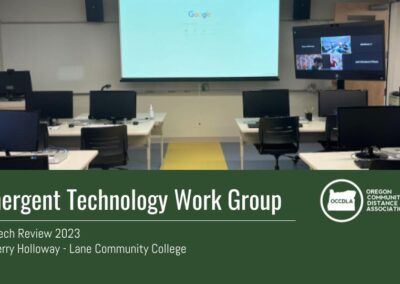EMERGENT TECHNOLOGY WORK GROUP - ED TECH REVIEWS
The Use of the SWIVL Tool to Enhance Online Pedagogy
by Frank Corona
Instructor, Business and Computer Science Department
Project Management Faculty Advisor
Clackamas Community College
June 12th, 2019
Exploration Intent
At Clackamas Community College we have proactively pursued tools and techniques to enhance our student’s experience with online courses. We have seen increased student interest in taking online courses, which translates directly to higher FTE. In my Project Management program, I have introduced additional online sections to courses that have traditionally been offered live or as hybrid courses which has resulted in increased interest and attendance. However, direct results of having these online courses as well as results of published articles and student course evaluations have provided some identified areas of concern and needed focus. One key area of concern that I decided to tackle was to promote more active student engagement in online courses. The adage “out of sight, out of mind” is unfortunately a common pitfall identified by students themselves when taking online courses.
As part of a multi-prong attempt to enhance and encourage this engagement, several key actions were identified. Weekly ZOOM video messages summarizing class topics, due dates, and other items of weekly interest, as well as video ZOOM office hours to complement the typical email chain of questions and/or concerns from students were proposed. But the most significant item that I wanted to pursue was the ability to post high quality archived video lectures onto our Learning Management System (Moodle) for our online courses.
My initial vision was a Ted Talks version of presentation, which are not only informative but engaging. However, upon briefly researching the equipment needed to duplicate this, I quickly realized that we needed to be more cost conscious in our approach.
The selection of the SWIVL system to record video lectures was initially driven by observation of a Portland State University doctoral study that used the SWIVL technology. Several considerations were considered when I was reviewing this as a tool of choice:
- Ease of Use and Setup;
- Costs;
- Flexibility of Use;
- Reliability of Product;
- Quality of final Product (video).
Upon further consideration, several other opportunities were identified that could further leverage the value of the SWIVL. These included:
- The ability for students to analyze results of face to face negotiations conducted in my Negotiation class;
- The ability to record sessions for posting on class days that fell on holidays or on “snow” days;
- Posting videos conducted of difficult material for subsequent student playback and review.
In fact, the application of item 1 above in my Negotiation class proved invaluable as a student resource in this study, based both on student evaluation and response.
Further discussion of each of these considerations as part of this evaluation will be discussed in the next section.
Lessons Learned
Ease of setup
The SWIVL system is surprisingly easy to set-up. The system is essentially composed of a tripod, the SWIVL system (including wireless microphones), and an iPad (see Figure 1 below). Prior to the initial use, each user needs to create a secure SWIVL account that allows videos to be uploaded into their storage cloud and then accessed easily afterwards. Set up time varies between 3 to 5 minutes in a classroom environment. The main components fit into a slim lightweight carrying case that measure roughly 6” X 12” (see Figure 2 below). All in all, the ease of use and of setup is easy and straight forward.

Figure 1

Figure 2
Costs
Although there are several options available, the basic unit which includes the SWIVL, 4 markers (microphones) and the tripod comes in at a less than $1000. This does not include the iPad, which can add ~$500 to the unit price. Considering the value this system has, this is a modest price.
Flexibility of Use
This tool demonstrated the flexibility to be used in multiple classroom environments. The unit can be placed on a table or desktop or can be mounted on the tripod. In the normal operation mode, the unit follows the presenter via a wearable marker which also serves as a microphone, so as the presenter moves around the room, the unit will track them to keep them in the video field of view. Likewise, for my negotiation class where students sat on opposite sides of the table to negotiate, the marker (microphone) was placed in front of them as tracking was not needed. The unit is very lightweight and can easily be move and repositioned as necessary.
Reliability of Product
To date, after multiple uses over the past term, no reliability issues were noted. The unit appears to be well made and robust. The carrying case that is provided offers enough padding to absorb small bumps and jostling. I was not able to find any posted negative ratings from other users of this product. As far as its operational reliability, no issues were encountered all term with tracking in a moderate size classroom and with overall operation. Functionally the system has operated flawlessly.
Quality of Product
The quality of the videos is a direct function of the iPad camera. With the option on the iPad to record either in 720p HD or 1080p HD, the video quality affects the size of the file. Depending on the nature of the recording and the length, this option should be further explored.
With normal recording, quality is enough to clearly show writing and markings on whiteboards, however the image on a projector screen of a PowerPoint presentation is washed out and undecipherable. However, the ability to edit the video and insert PowerPoint slides addresses this issue. In fact, this is a fantastic option in that the video will show in split screen format both the presenter and the presentation side by side. The user can program the slideshow to step through the presentation in sync with the video.
The other very useful feature is that the URL for each video can be downloaded and sent to recipients via email without the need for the recipient to have a SWIVL account. This also makes it easy to upload to the LMS for active review by students.
Overall, I was very happy with the results of the system, and an introductory training session held with my department elicited a favorable response.
Next Steps
The next steps in the use of the equipment will focus on the software editing capability of the videos in order to increase the quality of the videos. Being able to edit a three-hour lecture down to a more manageable level with strategic splicing of documents (syllabus, PowerPoints, spreadsheets, word docs, etc.) are exciting possibilities using this technology.
I want to thank OCCDLA for allowing us the opportunity to evaluate this system.
2021-23 ED TECH REVIEWS
TECHNOLOGY EXPLORATION
Do you have an emergent technology you would like to explore? Submit your nomination for a technology evaluation by the OCCDLA Emergent Technology Workgroup.
The OCCDLA Emergent Tech Work Group receives nominations for instructional technology review from work group members and our nomination form, available to all instructors and administrative staff of all Oregon Community Colleges.
Questions?
For questions about the Emergent Technology Work Group:
Administrative Contact:
Monica Marlo
Portland Community College
monica.martinezgallagher@pcc.edu



